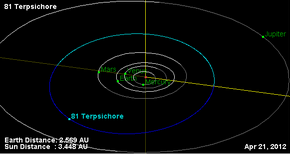 Orbital diagram Orbital diagram | |
| Discovery | |
|---|---|
| Discovered by | Ernst Wilhelm Tempel |
| Discovery date | 30 September 1864 |
| Designations | |
| MPC designation | (81) Terpsichore |
| Pronunciation | /tɜːrpˈsɪxərɛ/ |
| Named after | Terpsichore |
| Minor planet category | Main belt |
| Adjectives | Terpsichorean /tɜːrpsɪxəˈriːən/ |
| Orbital characteristics | |
| Epoch 31 December 2006 (JD 2454100.5) | |
| Aphelion | 516.955 Gm (3.456 AU) |
| Perihelion | 337.132 Gm (2.254 AU) |
| Semi-major axis | 427.044 Gm (2.855 AU) |
| Eccentricity | 0.211 |
| Orbital period (sidereal) | 1761.647 d (4.82 a) |
| Average orbital speed | 17.43 km/s |
| Mean anomaly | 149.581° |
| Inclination | 7.809° |
| Longitude of ascending node | 1.497° |
| Argument of perihelion | 50.234° |
| Physical characteristics | |
| Dimensions | 121.77 ± 2.34 km |
| Mass | (6.19 ± 5.31) × 10 kg |
| Mean density | 6.54 ± 5.62 g/cm |
| Synodic rotation period | 10.943 hr |
| Geometric albedo | 0.051 |
| Spectral type | C |
| Absolute magnitude (H) | 8.48 |
81 Terpsichore is a large and very dark main-belt asteroid. It has most probably a very primitive carbonaceous composition. It was found by the prolific comet discoverer Ernst Tempel on 30 September 1864. It is named after Terpsichore, the Muse of dance in Greek mythology.
Photometric observations of the minor planet in 2011 gave a rotation period of 10.945±0.001 h with an amplitude of 0.09±0.01 in magnitude. This result is consistent with previous determinations. Two stellar occultation events involving this asteroid were observed from multiple sites in 2009. The resulting chords matched a smooth elliptical cross-section with dimensions of 134.0±4.0 km × 108.9±0.7 km.
In popular culture
A space station orbiting 81 Terpsichore is the main setting in the science fiction story The Dark Colony (Asteroid Police Book 1) by Richard Penn.
References
- ^ "Terpsichore". Oxford English Dictionary (Online ed.). Oxford University Press. (Subscription or participating institution membership required.)
- ^ Carry, B. (December 2012), "Density of asteroids", Planetary and Space Science, vol. 73, pp. 98–118, arXiv:1203.4336, Bibcode:2012P&SS...73...98C, doi:10.1016/j.pss.2012.03.009. See Table 1.
- Asteroid Data Sets Archived 2009-12-17 at the Wayback Machine
- Tempel, M. (November 1864), "Minor Planet 81 Terpsichore discovered", Monthly Notices of the Royal Astronomical Society, 25: 31, Bibcode:1864MNRAS..25...31T.
- Pilcher, Frederick (July 2011), "Rotation Period Determinations for 28 Bellona, 81 Terpsichore, 126 Velleda 150 Nuwa, 161 Athor, 419 Aurelia, and 632 Pyrrha", The Minor Planet Bulletin, 38 (3): 156−158, Bibcode:2011MPBu...38..156P.
- Timerson, Brad; Durech, J.; Pilcher, F.; et al. (October 2010), "Occultations by 81 Terpsichore and 694 Ekard in 2009 at Different Rotational Phase Angles", The Minor Planet Bulletin, 37 (4): 140−142, Bibcode:2010MPBu...37..140T.
External links
- 81 Terpsichore at AstDyS-2, Asteroids—Dynamic Site
- 81 Terpsichore at the JPL Small-Body Database

| Minor planets navigator | |
|---|---|
| Small Solar System bodies | |||||||
|---|---|---|---|---|---|---|---|
| Minor planets |
| ||||||
| Comets | |||||||
| Other | |||||||
This article about a C-type asteroid native to the asteroid belt is a stub. You can help Misplaced Pages by expanding it. |